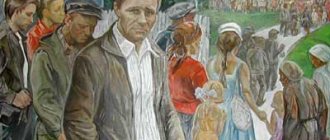One of the brightest literary works belonging to the early work of F. M. Dostoevsky is the story “White Nights”. The author himself classified his brainchild as a “sentimental novel”, thereby revealing the problems of love, loneliness, and the meaning of life described in it. We invite you to familiarize yourself with the analysis of the work according to a plan that will be useful to 9th grade students in preparing for a literature lesson.
Brief Analysis
Before reading this analysis, we recommend that you familiarize yourself with the work White Nights itself.
Year of writing : 1848.
History of creation - Immediately after writing, the novel was published in the journal Otechestvennye zapiski. Dedicated to the writer’s close friend, Alexey Pleshcheev.
Theme – Love, loneliness, search for the meaning of life. However, the central theme is the so-called “dreamers” - lonely young people living in an illusory world, but at the same time in need of real events and non-fictional feelings.
Composition - The work consists of five chapters: four of them represent the numbering of St. Petersburg nights, while the last one is called “Morning”.
Genre – Roman.
Direction – Sentimentalism.
“White Nights”, analysis of Dostoevsky’s story
The story “White Nights” was written by Fyodor Dostoevsky in the fall of 1848 and was soon published in the journal Otechestvennye zapiski.
In addition to the title, the writer gave his work two subtitles. The phrase “white nights” indicates the location of the action - St. Petersburg, and also symbolizes a certain fantasy, unreality of the events taking place. The first subtitle, “Sentimental Novel,” defines both the traditional genre of the work and its plot. The second subtitle, “From the Memoirs of a Dreamer,” informs readers that the events will be narrated in the first person. But can the dreamer be completely trusted in this matter?
As an epigraph, the author used a quote from Ivan Turgenev’s poem “Flower”:
...Or was he created in order to be at least for a moment. In the neighborhood of your heart?..
There is one inaccuracy here: the original contains a statement, not a question. Did Dostoevsky make a mistake on purpose? Without a doubt. In the new interpretation, the epigraph echoes the ending of the story and sets the tone of the storyline, making the reader think about the fate of the main character. Such diversity is characteristic of all of Dostoevsky’s work.
By choosing a first-person narrative, the writer gave the work the features of a confession and reflections of an autobiographical nature. It is not for nothing that some literary scholars recognize the young Dostoevsky the image of the main character Others believe that the prototype of the dreamer is the poet A. N. Pleshcheev, with whom Fyodor Mikhailovich had a strong friendship.
It is characteristic that the main character of the story does not have a name. This technique strengthens his association with the author or a close friend of the writer. The image of a dreamer worried Dostoevsky all his life. Fyodor Mikhailovich even planned to write a novel with that title.
The main character is an educated and full of energy young man, but calls himself a timid and lonely dreamer. He is immersed in romantic dreams, which he constantly replaces reality with. The dreamer is not interested in everyday affairs and worries, he performs them out of necessity, and, by the way, feels like a stranger in the world around him.
The work does not contain detailed references to the hero: where he serves, what type of activity he is engaged in. This further depersonalizes the main character. Lives without friends, has never dated girls. Such nuances make the hero an object of ridicule and hostility from others. The dreamer himself compares himself to a rumpled, dirty kitten who looks at everything around him with resentment and hostility.
Dostoevsky believes that ghostly life is sinful, it takes away from the world of reality: “a person becomes not a person, but some kind of strange creature of the neuter kind.” At the same time, dreams have a creative value: “he himself is the artist of his life and creates it for himself every hour according to his will.”
A dreamer is a unique type of “extra person.” But his criticism is directed exclusively inward; he does not despise society like Onegin and Pechorin. The hero feels sincere sympathy for strangers and even houses. An altruistic dreamer is ready to help and serve another person.
A tendency to dream about something bright and unusual was characteristic of many of the young Dostoevsky’s contemporaries. There was still clearly despair and disappointment in society caused by the defeat of the Decembrists, and the rise of the liberation movement of the 60s had not yet matured. Dostoevsky himself was able to abandon empty dreams in favor of the ideals of democracy . But the hero of “White Nights” never escaped from the sweet captivity of dreams, although he realized the destructiveness of his worldview.
The hero-dreamer is contrasted with the active girl Nastenka. The author created the image of a sophisticated and romantic beauty, a “soulmate” of the hero, but at the same time childish and a little naive. Respect is evoked by the sincerity of Nastenka’s feelings and desire to fight for her happiness. She is capable of running away with her lover and using a random acquaintance for her own purposes. At the same time, the girl herself constantly needs support.
The compositional structure of the story “White Nights” is quite traditional. The text consists of five chapters, four of which are called “nights”, and the last one is called “Morning”. White romantic nights greatly changed the protagonist's worldview. The meeting with Nastenka and his love for her saved him from fruitless dreams and filled his life with real feelings. A dreamer's love for a girl is pure and selfless. He is ready to sacrifice everything for Nastenka and help arrange her happiness, without even thinking that in the process he himself is losing his beloved.
The last chapter, “Morning,” is a kind of epilogue, full of drama and hope. The best moments in the hero's life end with the onset of a rainy, gray morning. The magic of the beautiful white nights disappears, the hero is lonely again. But there is no resentment or disappointment in his heart. The Dreamer forgives Nastenka and even blesses her.
Separately, the image of St. Petersburg . The city occupies so much space in the work that it can rightfully be considered a character. At the same time, the author does not describe specific streets and alleys, but masterfully recreates the amazing aura of Northern Palmyra.
“White Nights” is a beautiful utopia, a dream of what people can be if they are honest and selfless in their feelings. This work of Dostoevsky is one of the most poetic in his creative heritage. The fantastic nature of the white nights creates a magical romantic atmosphere of the story.
Literary critics consider Dostoevsky's White Nights one of the best works of "sentimental naturalism" . The touching story of the dreamer and Nastenka has not lost its significance to this day. She lives on the theatrical stage and in numerous film adaptations, including by foreign directors. The latest television version, where the action is transferred to our time, was created in 2009.
- “White Nights”, a summary of the chapters of Dostoevsky’s story
- “Crime and Punishment”, analysis of the novel
- "Idiot", analysis of the novel
- Analysis of the images of the main characters in the novel “Crime and Punishment”
- "The Brothers Karamazov", a summary of the chapters of Dostoevsky's novel
- "The Brothers Karamazov", analysis of Dostoevsky's novel
- “Poor People”, analysis of Dostoevsky’s novel
- “Demons”, a summary of the chapters of Dostoevsky’s novel
- “Humiliated and Insulted,” analysis of Dostoevsky’s novel
- “The Idiot,” a summary of Dostoevsky’s novel in parts
- “Poor People”, a summary of Dostoevsky’s novel
- “The Boy at Christ’s Christmas Tree,” analysis of Dostoevsky’s story
- “Demons”, analysis of the novel by Fyodor Dostoevsky
- “Crime and Punishment”, a summary of parts of Dostoevsky’s novel
- “Humiliated and Insulted,” a summary of parts of Dostoevsky’s novel
Based on the work: “White Nights”
According to the writer: Dostoevsky Fyodor Mikhailovich
History of creation
Fyodor Mikhailovich began writing the novel at the end of 1847, and already in 1848 the work was published in the literary magazine Otechestvennye zapiski.
In Dostoevsky’s early works, the writer’s obvious interest in the theme of “St. Petersburg dreamers” can be traced. It was to her that he dedicated several of his feuilletons in 1847, which were included in the collection “Petersburg Chronicle”. However, these articles were published by Fyodor Mikhailovich almost anonymously, since he signed the feuilletons with only the letters “F. M." Later it turned out that some of the material from the collection was used by the writer while working on the novel. In particular, these were the characteristics of the heroes and descriptions of everyday life.
Dostoevsky dedicated his novel to his close friend, the writer and poet Alexei Pleshcheev.
Subject
The central theme of the work is loneliness in a big city. This condition was very common in St. Petersburg in the mid-19th century, which was facilitated by the unstable social situation in the city. As a result, most young people felt lonely and deeply unhappy, having lost the meaning of life.
Nastenka and Dreamer are typical representatives of “little people”. They live a simple, modest and unpretentious life. Their circle of contacts is extremely narrow: the Dreamer communicated only with his colleagues, and Nastenka with her grandmother and residents. In order to escape from the gray reality and forget about pressing problems for a while, young people became “dreamers”, plunging headlong into their own fantasies.
The theme of love is revealed in the work through the prism of Nastenka’s feelings for her lover, and the Dreamer’s unrequited love for a fragile girl. The latter is not angry with Nastenka, blaming her for all his troubles when she leaves him completely alone. On the contrary, he comes to the conclusion that he needs to be grateful even for those moments of happiness that she gave him. He carefully nurtures his idea of happiness - even if there are only grains of true bliss in his life, he will forever keep them in his soul.
The main idea of the work is the isolation of “dreamers” from the real world, their inability to live among people and receive the joy of life from simple, everyday things. Preferring to have their head in the clouds, they inevitably doom themselves to loneliness.
Composition
The peculiarity of the composition of the novel lies in the interesting construction of the plot: the first four of the five chapters are devoted to St. Petersburg nights, while the last chapter is called “Morning.”
This most accurately reflects the dynamics of the development of the storyline - from sleep to awakening.
The construction is symbolic in nature. Against the backdrop of the romantic white nights of St. Petersburg, the reader reveals all the stages of the protagonist’s love for Nastenka, all his dreams and emotional experiences. But, in the end, “morning” inevitably comes - a moment of insight, which becomes a personal drama for the Dreamer. He has already found love, albeit unrequited, but so sweet. And now he is forced to say goodbye to her forever - the merciless morning dispels empty fantasies, but at the same time gives hope for a bright future.
The work is filled with various artistic techniques and means. Thus, Fyodor Mikhailovich skillfully uses the method of parallelism: almost every chapter begins with a detailed description of nature, which gives an involuntary hint as to how this chapter will end - cheerfully or sadly.
In addition to the two main characters - the Dreamer and Nastenka, a third character is invisibly present in the work, creating a special atmosphere. This is St. Petersburg, acting as an interlocutor and an old friend of the narrator. The city sensitively responds to the inner experiences of the Dreamer, creating an indescribably beautiful ambience for his romantic mood and justifying the meaning of the title of the work - “White Nights”.
The main theme of Dostoevsky’s novel “White Nights” is an essay
author: Ekaterina 09/13/2018 0 Comments
articles
school program
In his works, Dostoevsky raises the eternal problems of human existence that worried people both in the 19th century and now. One of the writer's earliest works, the novel White Nights, raises the topic of human social adaptation and an attempt to answer philosophical questions about what happiness is and what love should be like.
The article is written in the format of a school essay.
The main character of the work is reflected in the image of the Dreamer, behind whom it is not difficult to see Dostoevsky himself. This person differs from most others in his special way of thinking and attitude towards the world. The dreamer is constantly immersed in his thoughts, in which he creates ideal, in his opinion, plots and absolutely ideal people. He tends to dream about something bright and unusual, although he admits that deep down in his soul he is very timid and lonely, because he feels superfluous in the world around him. Most likely, reality does not correspond to the Dreamer’s idea of beauty, and he runs away from the difficult and cruel present into the world of his dreams.
Another important character is Nastenka, a sweet girl with whom the main character falls in love. The sudden love for her makes the Dreamer happy and returns him from sublime fantasies, albeit for a short time, to the real world. He is ready to do almost anything to make his beloved happy. But in the end, Nastenka leaves him and connects her fate with another person. And the Dreamer is again left alone and plunges into sadness and dreams.
Did the Dreamer and Nastenka have a happy future? Will such wonderful feelings be destroyed when confronted with real life? After all, they had known each other for so short a time, just a few days. But real relationships are everyday work, common problems that need to be overcome together. Would it have been possible for the Dreamer, a person with a complete lack of not only the experience of love relationships, but also simply the experience of ordinary communication? Maybe, despite the tragedy of the situation, this was the best scenario? After all, the bright feeling and good memories will remain with the Dreamer in the future, but disappointment in a real person, when love is broken by everyday life and disagreements, leaves deep wounds.
The Lonely Dreamer feels unaccepted by the world around him, a complete stranger in it. But at the same time, he does not despise society, but, on the contrary, feels great sympathy not only for unfamiliar people, but also for houses in St. Petersburg. The image of St. Petersburg in the novel also plays an important role. The city seems alive and friendly to the hero, and it seems to the Dreamer as if the trees and buildings on the street communicate with him and understand him. Throughout the novel, the reader can observe the constant reflection of the Dreamer. The hero analyzes his condition, feelings, reflects on his existence and his place in this world.
But still, the main character was not rejected by society. The dreamer himself fled into the world of his fantasies, he himself rejects the world, avoids other people. Meeting Nastenka was the first attempt at real interaction with the world, and it cannot be said that it was a failure.
The girl accepted him and tried to understand. And even agreeing to marry another man whom she fell in love with long before meeting our hero, Nastenka offers the young man continued friendship and communication. After all, she is also a dreamer, cut off from the world. True, not voluntarily, like the main character, but involuntarily, through the efforts of his grandmother. But Nastenka, unlike the Dreamer, is trying with all her might to return to the world, to escape from her grandmother’s wretched little world.
The composition of the work is constructed in a very original way. The novel "White Nights" contains 5 chapters - one morning and four nights. These nights were very important in the life of the Dreamer, because he was lucky enough to experience real feelings for a real girl. Yes, they turned out to be unrequited, but he retains the sublimity of his love and is grateful to Nastenka for it. His rejected love does not turn into hatred, as often happens in life and in books. The last phrase of the novel contains the main idea of the work: “A whole minute of bliss! Is this really not enough for even a person’s entire life?..” That is, the main meaning of life from the Dreamer’s point of view is love, which nourishes the soul and fills it with bliss. And anyone who has experienced it at least once can consider that they did not live in vain.
I advise you to look:
Summary of the novel “White Nights”
Don’t be greedy, share on social networks if the article was useful::
← Previous post
Next entry →







